|
<<< Back to Safety and Health Information Bulletins - Table of Contents by Year |
 Printing Instructions
Printing Instructions
|
|
 |
U. S. Department of Labor
Occupational Safety and Health Administration
Directorate of Science, Technology and Medicine
Office of Science and Technology Assessment
|
Guardrail System for Tunnel Form Stripping Platform
|
|
Safety and Health Information Bulletin |
|
|
SHIB 08-08-2006 |
|
|
This Safety and Health Information Bulletin is not a standard or regulation, and
it creates no new legal obligations. The Bulletin is advisory in nature,
informational in content, and is intended to assist employers in providing a
safe and healthful workplace. Pursuant to the Occupational Safety and Health Act,
employers must comply with hazard-specific safety and health standards
promulgated by OSHA or by a state with an OSHA-approved state plan. In addition,
pursuant to Section 5(a)(1), the General Duty Clause of the Act, employers must
provide their employees with a workplace free from recognized hazards likely to
cause death or serious physical harm. Employers can be cited for violating the
General Duty Clause if there is a recognized hazard and they do not take
reasonable steps to prevent or abate the hazard. However, failure to implement
any recommendations in this Safety and Health Information Bulletin is not, in
itself, a violation of the General Duty Clause. Citations can only be based on
standards, regulations, and the General Duty Clause. |
Purpose
To alert general contractors, employers, self-employed persons, and employees of
the risk of falling from elevations when using "netted" guardrail systems that
are frequently used in conjunction with tunnel form stripping platforms. Tunnel
form stripping platforms are elevated work platforms covered by the scaffold
standards, Subpart L (construction).
Method (Tunnel Forms)
"Tunnel forms" are steel components, consisting of a wall section and half of
the ceiling width of a room. The forms can be ganged 40 feet in length. They are
set in place on the opposing wall and the two sections of the ceiling form are
locked together. The forms are removed by lowering the jacks, rolling them out
through the open end of the structure on wheels built into the forms, and
picking them up with a crane
With heated tunnel forming systems, walls, floors and ceilings are cast at the
same time. Special heaters suspended inside the forms speed the curing process,
actually "baking" the concrete. This enhanced curing process allows the forms to
be stripped and repositioned the next day. Tunnel forms are best suited to
multi-family buildings and attached housing where room dimensions are repeated,
since multiple units can be created in a single pour.
Background
Occupational fatalities caused by falls remain a serious public health problem
throughout the United States. Data collected by the Bureau of Labor Statistics (BLS)
Census of Fatal Occupational Injuries Summary, 2004, reveal 815 fatal work
injuries involving falls.
Recently, an OSHA Area Office inspected a construction site where the high-rise
structure was being built using "tunnel forms." Figure No. 1 is an illustration
of the perimeter "netted" guardrail system which the Compliance Officer
observed. It consists of mesh rope netting attached to top, bottom, and vertical
metal tubing. The guardrail system attaches to the stripping platform, and
extends 39 inches above and 12 to 15 inches below the platform edge. There was,
however, a horizontal opening of 7 inches measured from the edge of the platform
to the netting. When a tape measure was used to push the netting away from the
platform edge, it created an opening of at least 19 inches.
As a result of the inspection, citations were issued. The opening between the
platform edge and the netting could expand to more than 19 inches, and allow an
average-sized worker to fall through the opening [Figures No. 2-1 - 2-4]. Thus,
the fall prevention system did not eliminate all fall hazards.
OSHA Requirements
The OSHA fall protection requirements for employees working on scaffolds are
provided in
29 CFR 1926.451(g). The type of fall protection required by OSHA
depends to some extent on the work activity. Paragraph
29 CFR 1926.451(g)
requires that employees on a scaffold more than 10 feet above a lower level be
protected from falling to that lower level. Where fall arrest is not used,
29 CFR 1926.451(g)(4)
requires guardrails to be installed on all open sides and ends of the platform.
Guardrail systems and components are to be designed and built to meet the
requirements of
29 CFR 1926.451(g)(4).
Specfically, when midrails, screens, mesh and intermediate veritcal members,
solid panels, or equivalent structural members are used, they must be installed
between the top edge of the guardrail system and the scaffold platform. Upon
initial observation by the Compliance Officer, the "netted" guardrail system
appeared to be securely fastened to the platform and adjoining side guardrails.
However, upon closer examination it became apparent that the design of the "netted" guardrail could easily have allowed an employee to fall between the
netting and the platform to the next lower level.
The netting and its framing could not support a downward or horizontal force as
specified in (g)(4)(ix). Although the top edge and side edges of the "netted"
guardrail was securely fastened, the bottom edge was not properly secured along
the length of the scaffold platform and along the entire opening between the
side supports as required by
29 CFR 1926.451(g)(4)(ii).
Employee Training
The employer must assure that each employee who performs work while on a
scaffold is trained by a person qualified in the subject matter to recognize the
hazards associated with the type of scaffold being used and to understand the
procedures to control or minimize those hazards. When netted guardrails are
utilized to protect scaffold perimeters, training must include the need to
properly attach the netting to prevent a fall hazard between the scaffold floor
and the netted guardrail.
The employer must assure that each employee who is involved in erecting,
disassembling, moving, operating, repairing, maintaining, or inspecting a
scaffold is trained by a competent person to recognize any hazards associated
with the work in question. In addition to instruction concerning relevant
requirements in
Part 1926, Subpart L, the training must include the following
topics, when applicable:
- The nature of scaffold hazards;
- The correct procedures for erecting, disassembling, moving, operating,
repairing, inspecting, and maintaining the type of scaffold in question; and
- The design criteria, maximum intended load-carrying capacity and intended use of
the scaffold.
Retraining. Retraining must be provided whenever there is evidence that an
employee no longer possesses the requisite knowledge and skills needed for safe
work involving the erection, use or dismantling of scaffolds. Retraining is also
required in the following situations:
- where changes at the worksite present a hazard about which an employee has not
been previously trained;
- where changes in the types of scaffolds, fall protection, falling object
protection, or other equipment present a hazard about which an employee has not
been previously trained; or
- where inadequacies in an affected employee’s work involving scaffolds indicate
that the employee has not retained the requisite proficiency.
Should netting or mesh be introduced as part of the scaffold guardrail system,
it would be necessary to include the need for netting attachment that prevents a
fall hazard.
Conclusion
All scaffold guardrail systems must be installed in accordance with the
provisions in 29 CFR 1926.451(g)(4). In addition, employers must comply with
employee training, inspection, and other OSHA scaffold provisions that apply to
the type(s) of scaffold used by their employees. Improper use of netting or mesh
used as guardrails for scaffolding can introduce fall hazards that may require
special attention during installation and inspection. Compliance with these OSHA
provisions will protect employees by diminishing the likelihood of injuries
associated with falls from scaffolds, including tunnel form stripping platforms.
Cut-Away View of "Stripping Platform"
(drawing not to scale)
Figure 1
For problems with accessibility in using figures and
illustrations in this document,
please contact the Directorate of Science, Technology and Medicine at (202)
693-2300.
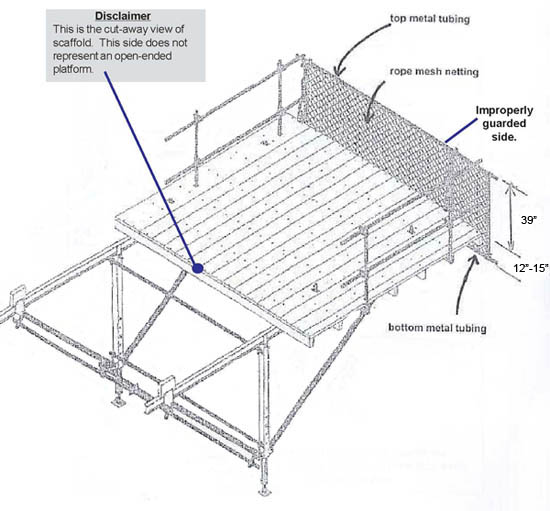
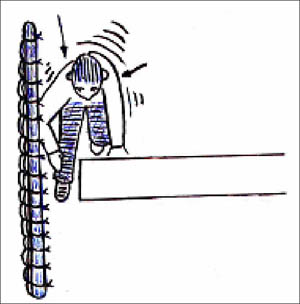
Figure 2-1. Description of the potential to fall - Employee steps into opening |

Figure 2-1. Description of the potential to fall - Employee steps into opening |
|
For problems with accessibility in using figures and illustrations in this document,
please contact the Directorate of Science, Technology and Medicine at (202) 693-2300. |
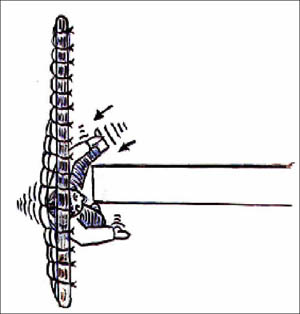
Figure 2-3. Momentum carries employee downward.
|
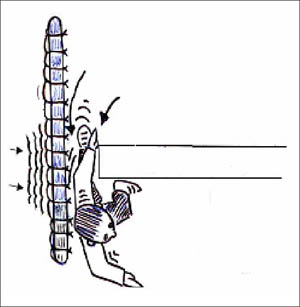
Figure 2-4. Employee clears floor edge and when the net tightens near the bottom rail it would have the tendency to push the employee out of the new. |
|
For problems with accessibility in using figures and illustrations in this document,
please contact the Directorate of Science, Technology and Medicine at (202) 693-2300. |
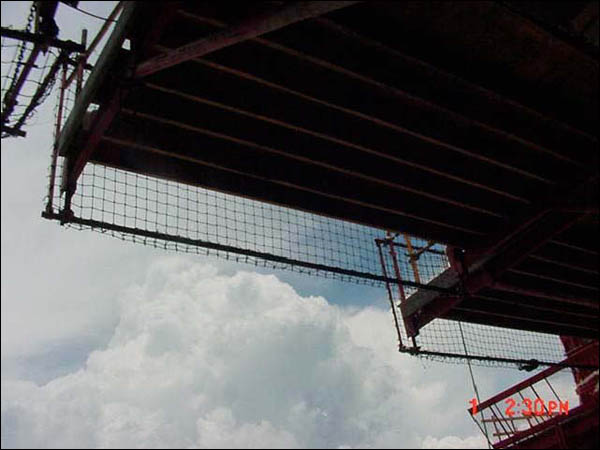 Underside of Stripping Platform showing mesh guarding.
Underside of Stripping Platform showing mesh guarding.
For problems with accessibility in using figures and illustrations in this document,
please contact the Directorate of Science, Technology and Medicine at (202) 693-2300.
|
| |

|

